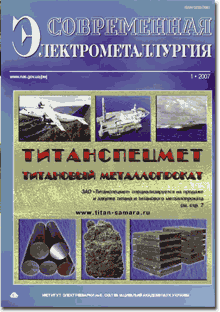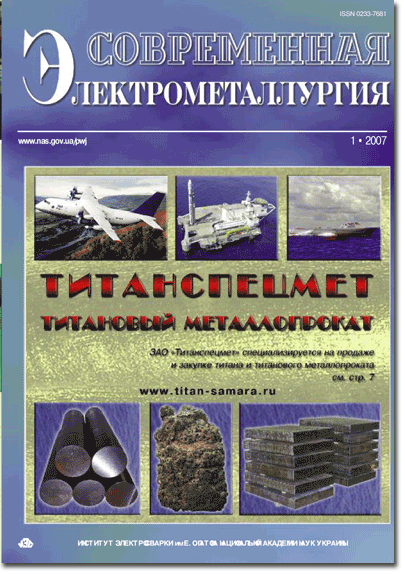

ELECTROSLAG TECHNOLOGY
Paton B.E., Medovar L.B., Saenko V.Ya., Tsykulenko A.K., Fedorovsky B.B. and Us V.I. New technological process of producing super-large steel ingots by ESC LM method 2
Some possibilities of the new technological process of producing super-large steel ingots using ESC LM method, developed at the E.O. Paton Electric Welding Institute and based on application of single or sequential multiple circumferential electroslag cladding of metal layer of preset composition on a central axial ingot or a forging of similar chemical composition and ensuring satisfactory homogeneous structure in the as-clad ingot, were considered. Main geometric parameters of round ingots of 100 t mass, clad with application of ESC process on the basis of 20 t ESR furnace, depending upon diameter of initial central ingot, were determined. Experimental investigations of model ESC ingots of 170 mm diameter, made from high-alloyed steel of 316L type, which confirmed their high homogeneity and good prospects of new process of enlargement of the section and mass of steel ingots, were carried out.
ELECTRON BEAM PROCESSES
Movchan B.A., Kurapov Yu.A. and Krushinskaya L.A. Investigation of a number of regularities of electron beam evaporation and condensation of carbon 6
Regularities of carbon evaporation and condensation in its electron beam evaporation through the tungsten melt are investigated, which allows significant increasing rate of carbon evaporation. Dependencies of the carbon evaporation rate and tungsten impurity content in the condensate upon heating power and angle of vapor flow incidence are obtained.
Trigub N.P., Zhuk G.V., Kornejchuk V.D., Ishchuk Yu.T., Severin A.Yu. and Davydov S.V. Commercial electron beam installation UE-5812 9
Design peculiarities and technical characteristics of new commercial electron beam installation UE-5812 are presented. The need of wide introduction of the installations of this class into titanium metallurgy is substantiated. Economic efficiency of this installation due to technical and technological advantages, in particular possibility of melting non-crushed blocks of spongy titanium, is shown.
Shpak P.A., Grechanyuk N.I., Osokin V.A. and Artemchuk A.A. Morphology of carbides and microstructure of steel R6M5 of electron beam remelting 12
Results of investigation of structure, chemical and phase compositions of high speed steel R6M5, produced by the method of electron beam remelting, in structure of which eutectic of two morphological types: prevailing laminar one (on the basis of metastable carbide M2C) and skeleton one (on the basis of M6C) are presented. Reduction of chemical inhomogeneity, high dispersion and uniformity of carbide distribution in EBR ingots are noted.
PLASMA-ARC TECHNOLOGY
Zhadkevich M.L., Shapovalov V.A., Melnik G.A., Zhirov D.M., Zhdanovsky A.A., Tsykulenko K.A. and Vislobokov O.M. Investigation of composition of burnt gas in plasma liquid-phase reduction of iron from ore raw materials by gaseous reducers 16
Change of burnt gas composition in time in the course of plasma liquid-phase reduction of iron from iron ore pellets by gaseous reducers in pyrolysis and air conversion of the pellets is determined with application of chromatographic analysis.
VACUUM-INDUCTION MELTING
Chervony I.F., Shvets E.Ya., Volyar R.N. and Golev A.S. Distribution of oxygen in single crystals of silicon and its influence on life time of non-equilibrium charge carriers 18
Influence of the background oxygen impurity and total concentration of impurities on life time of non-equilibrium charge carriers (NCC) in single crystals of silicon, grown according to Czochralski method and designed for application in solar power engineering, is studied. Issue of oxygen concentration and NCC life time distribution over a single crystal length is considered.
GENERAL PROBLEMS OF METALLURGY
Malashenko I.S., Kurenkova V.V., Onoprienko E.V., Trokhimchenko V.V., Belyavin A.F. and Chervyakova L.V. Mechanical properties and structure of brazed joints of casting nickel alloy JS26VI. Part 1 21
Interconnection between physical-mechanical properties of the seam metal and brazed joints with microstructure of casting nickel alloy JS26VI, produced with application of complex brazing alloys, containing boron and silicon as depressants, is considered. Silicon was added in the form of powder of commercial brazing alloy NS12 (NiД12 wt.% Si). The best results were achieved when 20 wt.% of NS12 were introduced into the complex brazing alloy. In this case brazed joints are characterized by strength at the level of 670Д760 MPa, and their relative elongation achieves 13 % at room temperature.
Tsykulenko K.A. Titanium. Problems of production. Prospects. Analytical Review. Part 1 28
In first part of the review social-economic aspects of titanium metallurgy, cost of titanium products, problems of spongy titanium production, and potential possibilities of Ukraine and its role in the world titanium industry are considered.
ELECTROMETALLURGY OF STEEL AND FERROALLOYS
Saviuk A.N., Derevyanchenko I.V., Kucherenko O.L., ProjdakYu.S., Stovpchenko A.P., Kamkina L.V. and GrishchenkoYu.N. Experience of producing especially low-carbon steel for plastic wire rod 35
Technological peculiarities of production in the complex arc steel furnaceДvacuumatorДladle-furnace of especially low-carbon grades of steel with guaranteed content of carbon below 0.01 % are considered. It is established that such content of carbon may be achieved by vacuum decarburization of the non-deoxidized metal. It is shown that for increasing degree of desulphuration before introduction of calcium-containing wire aluminium addition is necessary. Structure of the produced wire rod ensures its drawing without intermediate annealing processes.
Efimenko G.G. and Postizhenko V.K. State and vectors of development of electric steel production in Ukraine 40
Review of electric steel production in Ukraine is presented. Dependencies of economic development of the country upon structure of metallurgical production are shown. Reasons of lagging of electric steel production of Ukraine behind the world level are analyzed. Ways of development of electric steel production of Ukraine are scientifically substantiated.
ENERGY AND RESOURCES SAVING
Maksyuta I.I., Kvasnitskaya Yu.G., Simanovsky V.M. and Myalnitsa G.F. Increase of utilization factor of refractory alloy waste by electrometallurgy methods 44
Simultaneously with the system of intraplant accountability, classification, and certification of the wastes improvement the authors proposed, using example of the enterprise «ZoryaДMashproekt», new technology for filtration and refining of the melt in vacuum remelting of off-grade wastes of multicomponent nickel alloys in the serial melting unit PMP-4M for the purpose of producing a secondary charge billet. The process envisages seasoning of the liquid metal in a specially designed multilevel mould with ceramic filter. This ensures efficient zone cleaning of the metal due to pushing off of the impurities from solidification front with subsequent removal of the cast ingot problematic zone by machining. Carried out organizational-technical measures in experimental-commercial testing of the proposed technology showed possibility of increasing utilization factor of cast waste in casting of items from 30Д40 to 70Д80 wt.% depending a type of the items.
Developed at PWI 48
(You are viewing the simplified file contents)
The cost of subscription/purchase order journals or individual articles
| Journal/Currency | Annual Set | 1 issue printed |
1 issue |
one article |
| TPWJ/USD | 384 $ | 32 $ | 26 $ | 13 $ |
| TPWJ/EUR | 348 € | 29 € | 24 € | 12 € |
| TPWJ/UAH | 7200 UAH | 600 UAH | 600 UAH | 280 UAH |
| AS/UAH | 1800 UAH | 300 UAH | 300 UAH | 150 UAH |
| AS/USD | 192 $ | 32 $ | 26 $ | 13 $ |
| AS/EUR | 180 € | 30 € | 25 € | 12 € |
| SEM/UAH | 1200 UAH | 300 UAH | 300 UAH | 150 UAH |
| SEM/USD | 128 $ | 32 $ | 26 $ | 13 $ |
| SEM/EUR | 120 € | 30 € | 25 € | 12 € |
| TDNK/UAH | 1200 UAH | 300 UAH | 300 UAH | 150 UAH |
| TDNK/USD | 128 $ | 32 $ | 26 $ | 13 $ |
| TDNK/EUR | 120 € | 30 € | 25 € | 15 € |
AS = «Automatic Welding» - 6 issues per year;
TPWJ = «PATON WELDING JOURNAL» - 12 issues per year;
SEM = «Electrometallurgy Today» - 4 issues per year;
TDNK = «Technical Diagnostics and Non-Destructive Testing» - 4 issues per year.





